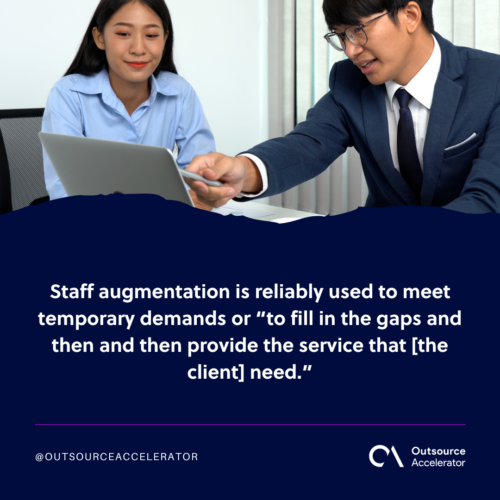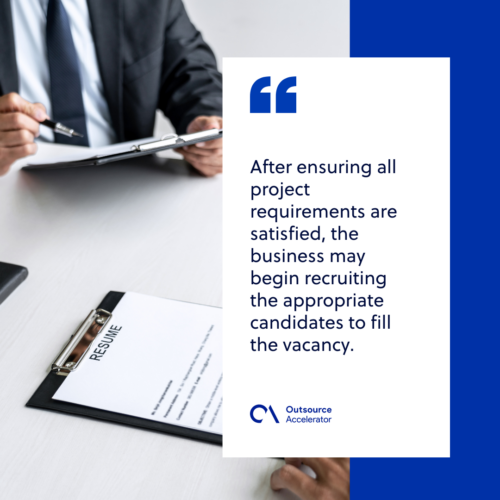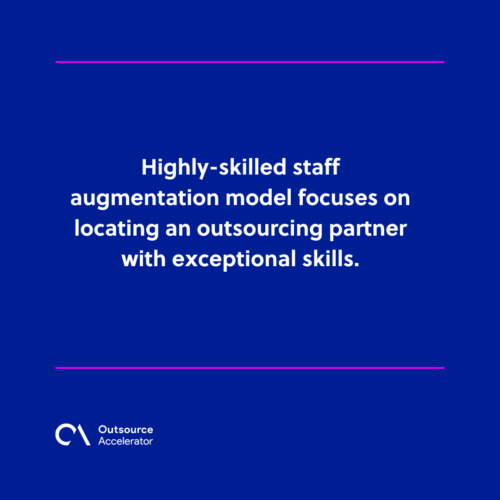Here’s your quick guide to the staff augmentation model

Hiring new employees can be more expensive than retaining the current ones.
Fortunately, there are several ways businesses can cost-savingly increase their workforce without replacing workers: outsourcing, cross-training, and automation.
But among these strategic staffing, there’s another strategy that lets you hire additional employees while retaining your team — staff augmentation.
When choosing a staff augmentation model for software development, it’s vital to follow global staffing industry trends.
In the 426th episode of the Outsource Accelerator Podcast, Sourcefit President and CEO Andy Schatchel discussed outsourcing to the Philippines and the staff augmentation model.
Staff augmentation defined
Staff augmentation is a staffing technique that expands an existing staff with new workers.
It is a cost-effective way to boost a business’s capacity without hiring full-time personnel.
As per the Sourcefit CEO, this method is “a great way for [companies] to ensure more business continuity and lower costs, competitive pricing going forward into the future.”
Staff augmentation is reliably used to meet temporary demands or “to fill in the gaps and then and then provide the service that [the client] need.”

In addition, it enables enterprises to acquire individuals with specialized talents and expertise when necessary, such as when a company wants to add particular skills to its staff.
Through staff augmentation, companies can access a bigger talent pool.
But when recruiting workers from beyond the local region, it’s safer for businesses to take it slow.
This is essential because “of course, if it’s [the client’s] first foray into outsourcing, they’re going to want to take a cautious approach,” Andy advised.
How does staff augmentation work?
Here are the three steps of the staff augmentation model:
Gathering project requirements
The business must first determine its project requirements.
It involves monitoring the performance of its current employees and determining which areas are needed to fill. You can ask the following guiding questions:
- Is it time to expand your business?
- When is the season most in demand for your company’s services?
- In which area of your business will you need additional personnel most?
The company must also ensure that the augmented employee adheres to the organization’s standards.
This “[is] a very sensitive area because, you know, of course, people take the rights of employees and the local labor laws very seriously in each market.”
Staff augmentation involves gathering project requirements, identifying needed skills, and integrating augmented staff into a team’s existing resources.
This process ensures that the entire project’s demands are met by supplementing the team with professionals possessing the required expertise.
Selecting the right team
After ensuring all project requirements are satisfied, the business may begin recruiting the appropriate candidates to fill the vacancy.
This may be accomplished through different channels, including employment agencies, job boards, and social media.
Recruitment specialists must ensure that the augmented employee fits the following qualifications:
- Skills
- Capabilities
- Level of knowledge
- Collaboration tools
- Availability
- Project schedule

Staff augmentation involves selecting the right team to complement your in-house team.
This approach enhances your existing team by integrating a specialized augmented team that caters to specific skill gaps or additional expertise required for projects.
By selecting a dedicated team through staff augmentation, businesses can ensure that their workforce remains flexible and adaptable to changing demands.
Onboarding the selected team
Once the appropriate employees have been selected, you may start the onboarding process.
Next is to guarantee that the new employees are incorporated into the current team and grasp the organization’s culture and values.
Understandably, some may take longer to be culture fit, but “as long as they’re they’re engaged, and that [companies are] putting clear expectations in place for their outsourced staff then, they can be successful using [this] approach,” Andy encouraged.
Project managers play a crucial role in overseeing and coordinating the augmented team, ensuring that objectives are met efficiently.
By leveraging staff augmentation, businesses can dynamically scale their IT workforce, optimize project execution, and effectively achieve strategic goals.
Staff augmentation vs. Managed services
Staff augmentation is a more convenient way to expand your current team with personnel having the same skills as your existing employees.
“If someone’s working remotely down the street or in the next town over, why not hire someone for a fraction of the cost who can do the same work, who just happens to be sitting in another country?” the Sourcefit CEO stated.
On the other hand, managed services are a more comprehensive approach to IT management.
It entails a third-party provider managing and maintaining the organization’s IT infrastructure.
Managed services are more transparent because third-party providers must produce accurate reports.
To support this statement, Andy acknowledged that “managed services have a high level of transparency.”
3 types of staff augmentation
There are several types of staff augmentation, but here are the three most significant ones:
1. Commodity
Commodity augmentation is a business strategy in which a corporation employs temporary workers to execute a particular project or set of duties.
2. Skill-based
Skill-based augmentation is where firms identify the necessary skills and requirements for a long-term or a short-term project.
There are three factors to consider when considering skill-based staff augmentation:
- Determine the necessary abilities and expertise
- Locate specialists with these talents
- Include an expert in your team and manage the connection
3. Highly-skilled
Highly-skilled staff augmentation model focuses on locating an outsourcing partner with exceptional skills.
Andy noted, “Some clients need more help. They need us to be more involved, and they need more from us.”
That’s why it’s critical in this staff augmentation model to exceed clients’ expectations.
One of the monitored criteria is the augmented staff’s ability to deliver top-tier results to assist a firm in acquiring a competitive advantage.

Choose the staff augmentation model that suits your organization
While it’s nice to adopt all three types of staff augmentation models, choosing the most suitable one is vital.
Selecting the right approach can enhance your in-house team’s capabilities by seamlessly integrating external tech talent.
Companies with in house development team may use staff augmentation services to fill skill gaps or meet project demands without hiring full-time employees.
If you choose the most compatible approach for your organization, you may get the most out of your personnel and optimize the value of your resources.
Is staff augmentation right for you?
When you engage temporary personnel to work in-house, you may have better control over the process, especially when you recruit “the right types of people.”
But before you consider staff augmentation, you should first weigh its pros and cons. Dig deeper into its process.
You must also assess what staff augmentation model will suit your business best.
If you want to learn more about staff augmentation, Andy Schachtel would be happy to connect with you.
Visit Sourcefit’s official website and listen to episode 426 of the OA podcast here.







 Independent
Independent




